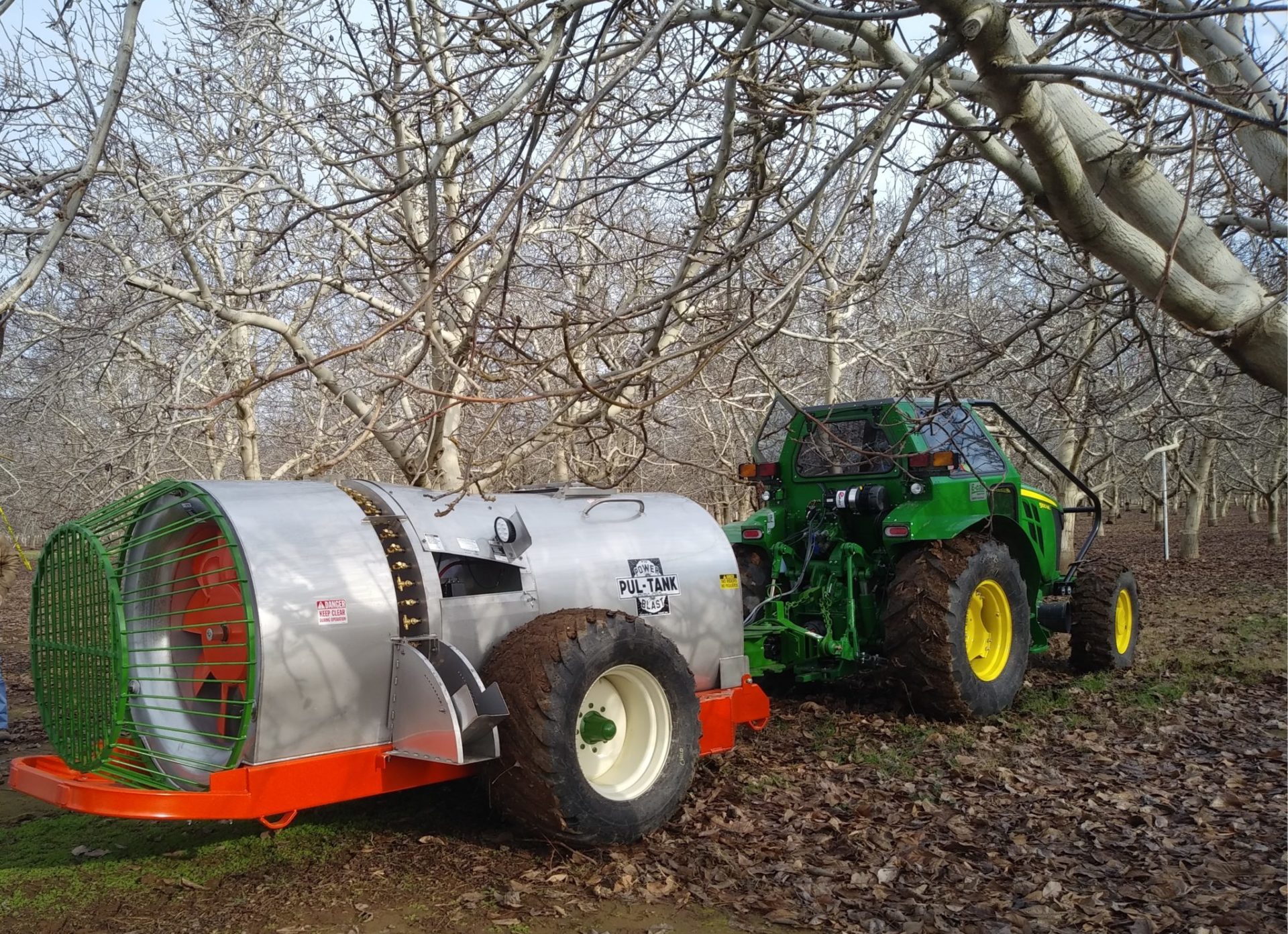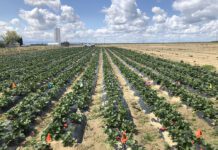
Experienced nut growers and pest control advisers (PCAs) understand the importance of orchard spraying to the production of a high-quality crop. Missing the mark on a crop protection spray can have a devastating impact on yield or quality. Most have experienced the gut-wrenching feeling of walking into an orchard and seeing damaged nuts on the ground due to an application error. These painful losses usually cause growers to look for ways to improve their sprays next season, either in timing, coverage or material selection.
Unfortunately, implementing these types of improvements in spray programs is becoming more of a challenge. In addition to lower nut prices, the increase of labor and input costs, loss of registered active ingredients, greater pest pressure and regulatory restrictions have made it more difficult to maintain an effective spray program, let alone improve it. Often equipment and personnel constraints can translate into sacrificing optimal spray timing or coverage.
In light of these growing challenges, innovative companies and university researchers have responded with new spray technologies for orchard crops. These technologies are transforming the way orchards are sprayed, which has remained largely unchanged for the last 50 years. Many of these sprayer technologies have been made possible by adapting more advanced sensor, communication and computing technologies now available to orchard spray equipment and processes.
Sprayer Automation
One of the most promising areas of development has been the automation of orchard spraying. Essentially, this means that instead of equipment being controlled manually by an operator, it operates to some degree automatically. Some companies have built sprayers that automatically target just the tree canopies, for example, in young plantings. The advantage of this technology is reduced per-acre spray volumes and therefore, more acres sprayed per tank.
Targeting systems are not limited to airblast sprayers only. Post-emergent weed sprays are an opportunity for automation in spraying as well. Neil Knaak, owner of West Coast Weedit, describes precision herbicide applicators as, “Basically a mechanized hand-spray”. Unlike hand sprays, though, the processing power on board, combined with the right sensors, is one of the big factors making precision weed spraying a reality.
“With this technology now, the system is sampling the ground 40,000 times per second for target tissue,” he said. “It’s a tremendous amount of processing going through the sprayer.”
It is easy to understand the potential chemical savings on post-emergent herbicide applications in situations when weed pressure is low or varied throughout the field.
Autonomous Sprayers
Another company, GUSS Automation, has combined a variety of advanced technologies to pioneer the first autonomous, air-blast sprayer. Developed out of a vision to improve the efficiency, precision and safety of spray applications, the GUSS (Global Unmanned Sprayer System) sprayers are being used by commercial applicators and orchard growers in California, Florida and soon in Australia. Though the company originally assumed only growers large enough to purchase multiple sprayers would be interested since one operator can control up to 8 units, they have been surprised to find some purchasing just one. GUSS COO Gary Thompson said, “It is amazing to see how much benefit in efficiency that those guys pick up. While GUSS is spraying, the operator can be at the pump, monitor GUSS on the laptop, fill the nurse tank and mix into it, and drive back to the field before the sprayer is ready for a refill.”
Besides the efficiency gains, growers may also benefit from the precise controls, tracking and safety features autonomous sprayers are equipped with. Other companies are taking a different approach, and developing autonomous controls for the tractor instead of the sprayer. Brent Davis, President of Air-O-Fan Products,
shared, “I don’t want any one implement to be an expensive tool that doesn’t get used all the time. Ultimately, the tractor needs to be the autonomous piece, as it will have multiple tasks throughout the year.”
This approach may benefit growers with current PTO- or engine-driven sprayers that they are not ready to replace, or other implements regularly utilized in the orchard.
Aerial Platforms
Ground-based sprayers are not the only type of system experiencing a surge of innovation. Aerial systems, particularly Unmanned Aerial Systems (UAS), are in development or commercial use on a number of crops. But when it comes to orchard crops, including tree nuts, Peter Larbi, a UC Cooperative Extension specialist in spray application engineering said, “One of the primary limitations for UAS spraying in orchard crops is the payload.”
UAS systems do not currently have the tank capacity to meet coverage or label requirements in an efficient
manner. However, he does see drones playing a greater support role in the future as adoption increases. Chandler Bennett of Parabug, a biocontrol application service, has found a valuable niche for UAS technology in tree nuts. Though not technically a sprayer, the UAS system is capable of delivering a variety of biocontrols to tree canopies for insect pest management, covering up to 1,800 acres per day, per drone. Regarding the initial skepticism that the UAS biocontrol applications would be effective, Chandler observed that, “Although a lot of the growers were a little bit worried about that, at least on trees where the canopy was not fully enclosed in the rows, they have all been very happy with the results.” He does advise growers, though, “If it’s going to be affordable, it must be done on a preventative basis.”
The light payload, mobility of the beneficials, and application speed has proven UAS systems to be a highly efficient method of augmented biocontrol in tree nuts, both organic and conventional. UAS systems are
also supporting spray applications by collecting imagery and identifying areas of fields for additional monitoring or spot applications.
Evaluating Performance
Although grower adoption of new sprayer technology is increasing, there are still significant barriers to overcome before widespread adoption is seen in tree nuts. First and foremost is the cost, including the initial purchase and setup costs for automated sprayers, as well as the long-term operating and maintenance costs. You know the costs for operating your sprayers. Factor in maintenance costs for employee training, sensors and other hardware when making ROI calculations on automated systems. Second, growers must have confidence in the performance of the technology.
“A lot of growers find it difficult to adopt new technology until they can trust that it will positively impact the bottom line, and would not want to change anything until they know that it will be useful; because change is hard,” said Larbi.
Try to connect with growers or applicators who are using the application technology already. Ask about operational changes they needed to make in order to maximize the technology’s benefit. See if
there are performance issues that need to be addressed. Find out if they are experiencing break-downs and getting prompt service.
When it comes to spraying orchards, it is exciting to see experienced ag companies pioneering the future of sprayer technology. At the same time, the basic principles of effective spraying still apply, regardless of sensors and controls. Equipment calibration and maintenance, nozzle selection, air volume, droplet size and distribution, ground speed, and, of course, timing are all just as critical. Larbi summarized it well when he
said, “No matter the technology that is used, at the end day we want it to be working, and it should be effective, delivering the material to where it is needed, so it can do the job. Otherwise it is just cool.”















